Some people have said there is no better place to see fall than at historic Greenfield Village.
I concur.
Now, I know we still have plenty of Fall left, but Thanksgiving is nigh, welcoming the Christmas season, which, for me, changes everything. Yes, Christmas is a season in itself.
But for now, let us welcome Fall.
~
You will see a mish-mosh of different photographs in today's posting, for it actually begins in late summer - fall doesn't start until around September 21st, as you probably know - and the season in this posting carries us through most of November, when the feeling becomes more winter-like than autumn.
Fall is my favorite time of year and I really begin to think about it in August when the hint of harvest time wafts through the air.
But I have a sheer bout of actual giddiness when the "ber" months arrive: September, October, and November.
In September I always take my annual Labor Day visit to the Village. I started this tradition around four or five years ago, and it's been a good one for me, for, in a way, it's sort of like my own personal Lammas Day which actually takes place on August 1 when many colonial farmers began celebrating the fall harvest; Lammas Day (or Loaf Mass Day) marked the first major harvest of what was once considered to be the beginning of the fall season.
So, as I said, coming to Greenfield Village on Labor Day was like my own personal Lammas Day.
Let's begin there:
 |
| The fence surrounding the Ford Farm remains patriotically dressed in red, white, and blue bunting for most of the summer season and into early fall. |
 |
| Here we are looking toward the front Firestone Farm field...and besides corn I see the little red cider mill in the distance. |
 |
| Ahhh...there it is! My favorite house inside Greenfield Village! Can you say Daggett? |
 |
Okay...I'm getting a little artsy here with these two pictures. |
 |
| And inside the great hall of Daggett we see Jan spinning on her wheel. |
 |
| Preparing their winter wood. |
 |
| A bit later in September and we can see fall is well on its way at the Daggett House and their kitchen garden. |
 |
| We had very un-fall-like weather during the month of September. Summer decided to stay with us for a bit. |
April of 2022 will be an exciting month at Greenfield Village, for upon re-opening for the new season we will be able to witness the grand opening of their latest historical addition - the first one since 2000: a 19th century farmer's market!
Also during the later part of September Greenfield Village hosts an Old Car Festival, which I enjoy greatly. And it's on the Saturday of this event that the Village remains open until 9:30 - clear until dark!
And that gives us a great opportunity for some pretty cool night time camera shots:
 |
| Not moon over Miami, but moon over Dearborn. To be exact...how about Harvest moon over the Ford home! |
And now we are at the very end of September - my last time visiting the Village for nearly two months - and fall can be seen quite plainly:
 |
| In fact, here we see Roy preparing to make a fire, possibly for soap making... ...or perhaps to brew beer. |
 |
| Here at September's end the garden at the Edison cottage has a fall flare to it. That's the beautifully picturesque Ackley Covered Bridge, built in 1832, in the background. |
 |
| A side view of the Firestone Farm, from the 1880s. |
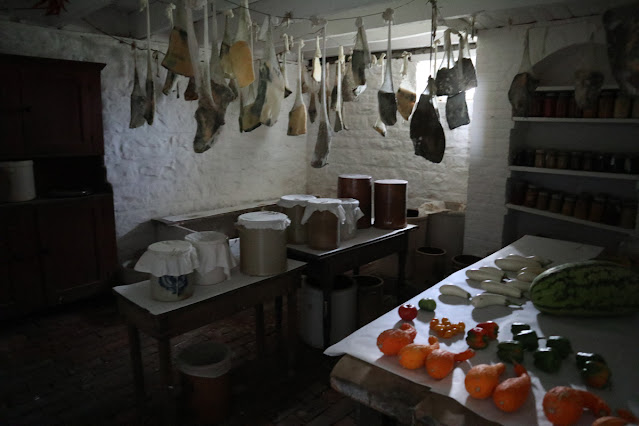 |
| And some of the early harvest in the Firestone cellar. By mid-October this cellar gets pretty full. |
 |
| One of the heirloom apple trees in the Firestone Farm apple orchard. This year they planted a new generation of trees of the ancient fruit. |
I've already mentioned in previous posts that I was very sick in October and was out of commission the entire month.
Yes, seriously ill.
But toward the end of October I began feeling better...a little better one day at a time, and really started feeling well come November. Not perfect, mind you, but well enough to feel like living again and doing things I love.
 |
| After being seriously ill, this was a sight for sore eyes! |
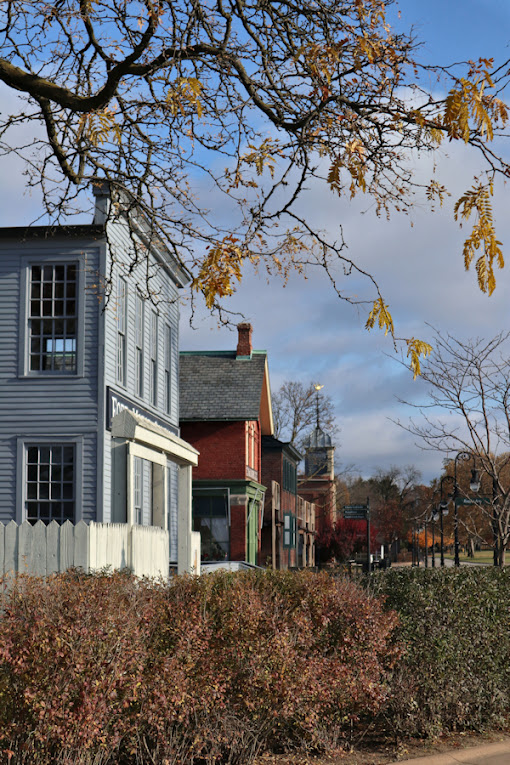 |
| If I see something appealing in a different way, I try to capture it. This is one of those scenes...or perhaps a sort of vignette. |
 |
| The sun shining through the tree near the Wright Brothers Home. |
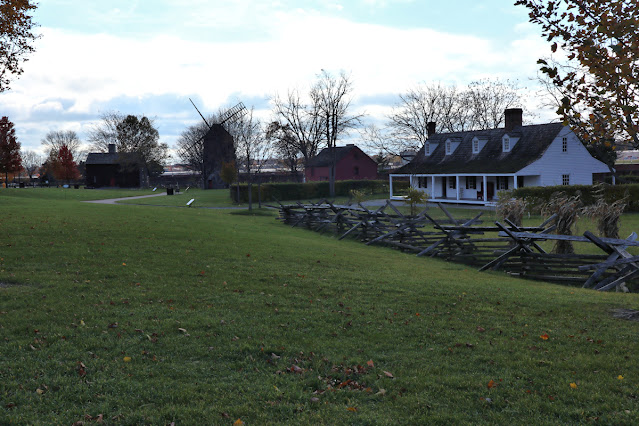 |
| Well, you know where I'm heading to, right? Yep, we see Susquehanna to the right, the little red Plympton House centered, the Farris windmill, then the Daggett House. |
Now let's take this history just a bit further...just imagine...the Daggetts, who lived in this house, were once living human beings like us and not just characters in a book. They had feelings the same as we do: they felt happiness, sadness, fear, anger, pain, concern, and contentment. They celebrated the coming of spring and of the harvest time. They enjoyed church picnics and weddings, and certainly mourned the loss of loved ones, whether friends or family. They spoke of their crops, the weather, told stories, and studied the Bible. One can only imagine the discussions and probably even debates they had of the news of the day - how wonderful it would be to be able to hear conversations and opinions about Paul Revere's famous ride (for it actually did make the papers/broadsides throughout much of the colonies at the time), of the Revolutionary War itself, their thoughts on the Declaration of Independence, the forming of the new nation with its own Constitution, and hearing of George Washington becoming our first president as it was happening! I mean, if the Daggett house walls had ears, they most certainly would have heard at least some talk about these great events.
Yes, if the walls could talk...
Think about your own debates inside your own home, whether it's about politics, the pandemic & vaccinations, the current inflation, or perhaps the robots the United States has placed on Mars.
The topics may have changed somewhat, but discussions still rage on.
 |
| Jane & Gigi were both working with yarn here on this gray November day while a fire roared in the fireplace. |
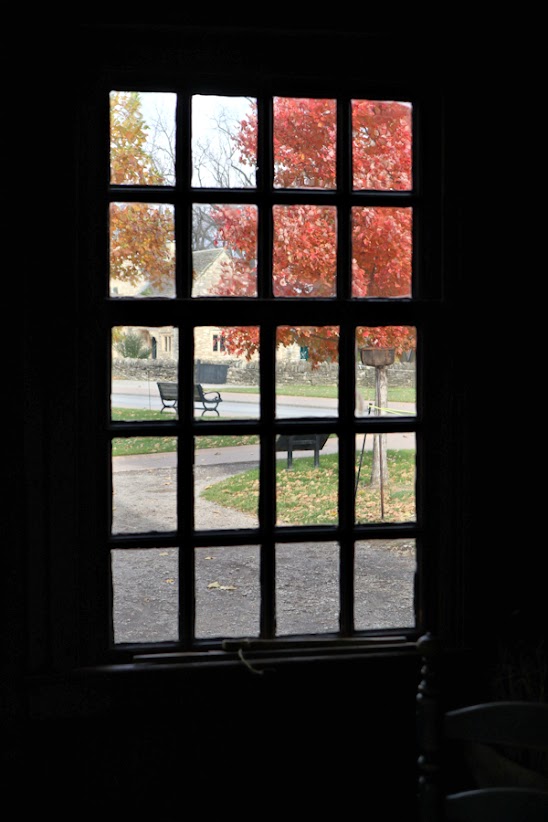 |
| Framing the frames which are framing the beauty of autumn. The window frame you see here is over 250 years old! |
I usually spend extra time inside the Daggett House - generally more time than any other structure there - but I always back off when other visitors show up. I, in no way, wish to take away from anyone's visit, so I may head into the kitchen and then out to the garden, then oftentimes will find my way back inside. Sometimes this can pay off, for one can see the presenters suddenly take on a chore or do something one does not often see, even something mundane like sweeping a floor of autumn leaves can become picturesque:
 |
| Gigi decided to sweep up the fallen leaves that had found their way into the great hall and parlor, and moved the candle stand in order to get behind it.  |
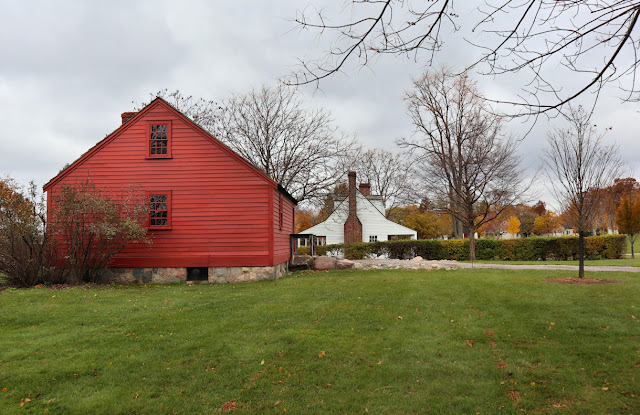 |
| Just outside the Daggett door we see the Plympton House, which is nearly 50 years older than the Daggett House. |
In early November we had a Sunday filled with snow flurries. Nothing that really stuck on the ground or anything. But the first snowfall of the year always seems a bit magical, especially if you happen to be at Greenfield Village.
Unfortunately, I was not. I had previous plans with my family.
However, there were plenty of visitors who had showed up and took some pretty amazing pictures, some of which I am using here.
 |
| Ed Davis, who took this picture, and I both agree that the Daggett House is our favorite! |
I do plan another visit or two before the Village closes its gates for daytime visits. This means I will most likely have more fall photos to share. And I will be at one of the Holiday Nights nights in December for this wonderful timeline of 300 years of Christmas season celebrations. Yeah...you know I enjoy taking loads of photos there as well.
I only wish they were open during the winter months of January, February, and March.
Alas, they are not.
But I will look forward to its re-opening in mid-April, which for us "Village People" is akin to baseball's opening day, for the build up is every bit as strong with anticipating, that's for sure.
Stay tuned for another fall in the past at Greenfield Village coming soon - - - -
Until next time, see you in time.
~ ~ ~












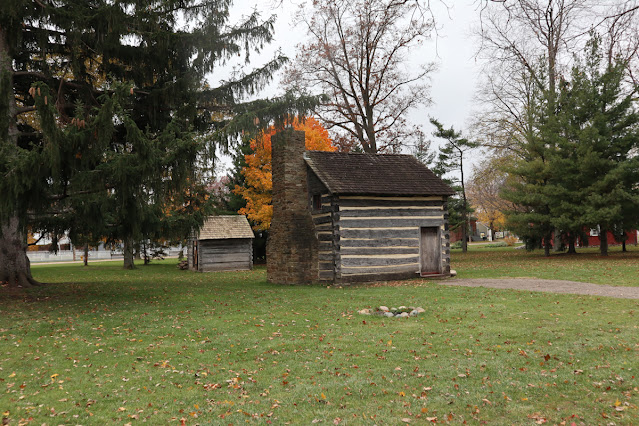


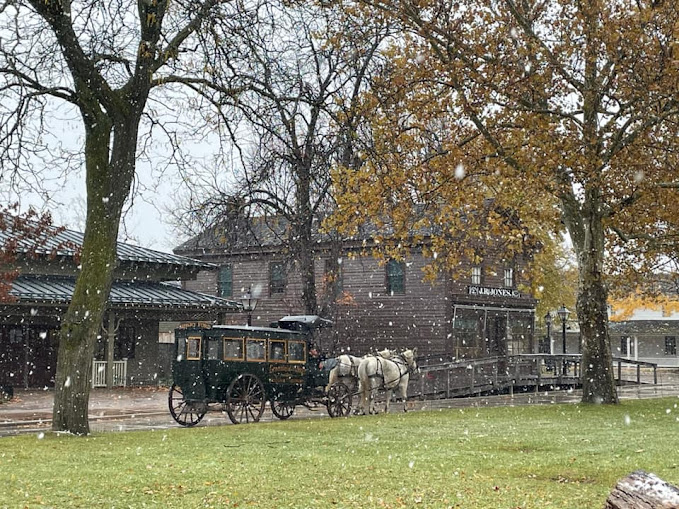
Oh, I think the Chapman house is perfect! I like the little old houses - as long as the fire keeps it warm (yea, I know they weren't that great.) It's a darling house. Looking forward to the Christmas season this year more than last year even.
ReplyDelete